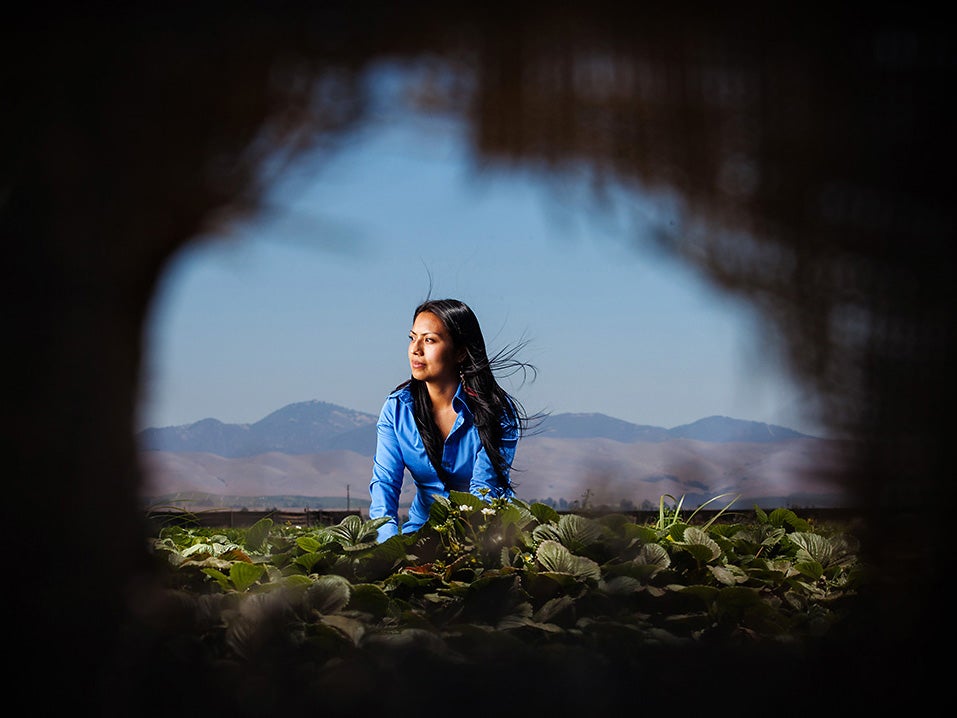Protecting Farmworkers from a Poisonous Legacy
A petition to ban chlorpyrifos, a toxic pesticide, paves the way for even greater farmworker protections.

This page was published 9 years ago. Find the latest on Earthjustice’s work.
Olga Santos was only six when she started working in the fields. When she was sprayed with toxic pesticides while eating lunch with her family, help was nowhere to be found.
“They would spray pesticides near us over and over and there was nothing that could be done,” Santos said in an interview with Earthjustice. “As a child, there is not much you can do other than try to speak up as loud as you can. My parents were fearful of losing their jobs, so they wouldn’t say much.”
For many farmworkers, pesticides are inescapable. Poison lingers in the air they breathe, on the crops they work and on the clothes they wear. Over time these chemicals take a toll, wreaking havoc on eyesight and other essential central nervous system functions. Up to 20,000 pesticide poisonings are reported every year, and many more may go undeclared.
This September, Earthjustice represented a coalition of farm worker, labor and community health groups as they petitioned the EPA to immediately suspend chlorpyrifos—a particularly dangerous pesticide—from hundreds of uses. This suspension would take into account risks to handlers performing seed treatments and to workers who enter fields and greenhouses after chlorpyrifos spraying.
Chlorpyrifos is in the organophosphate class of pesticides. Organophosphates were developed for chemical warfare by the Nazis during World War II. Chlorpyrifos is extremely toxic, causing systemic illness to workers by inhibiting the body’s ability to transmit nerve signals. For children, exposure can cause irreversible brain damage, including reduced IQ, attention deficit disorders and learning disabilities. In 2000, the U.S. EPA found that at-home uses of chlorpyrifos harm children who play on pesticide-treated carpets or hug their pets after a flea bomb goes off. But the agency left farmworker children unprotected.
Our EPA petition seeks immediate action to stop uses of chlorpyrifos that the agency has determined pose an unacceptable risk of acute poisoning to workers. It also asks the EPA to protect children from exposures that can cause irreversible brain damage.
“Farmworkers are simply seeking what others have in this country—a safe workplace. Nothing more, nothing less,” said Ramon Ramirez, President of Pineros y Campesinos Unidos del Noroeste, Oregon’s farmworker union. Until now, the EPA has failed to protect field laborers and their families from chlorpyrifos. This petition is a huge step forward in the fight to secure safe working conditions for these communities.
“Farmworkers are simply seeking what others have in this country—a safe workplace. Nothing more, nothing less.”
Farmworkers rely heavily on the federal Worker Protection Standard to safeguard their health. Until recently, this standard had not been updated for more than 20 years, depriving farmworkers of protections that most workers in the U.S. enjoy. But a little more than a year ago, Earthjustice worked with farmworker advocates to push for an update. In a resounding victory, the EPA substantially improved farmworker safeguards. The updated rule establishes a minimum age of 18 for pesticide handlers, increases the frequency of mandatory worker safety trainings from once every five years to once every year, and improves the quality and content of these trainings. The new rule also provides guidelines on personal protective gear and ensures that safety information is provided to farmworkers in various languages.
But despite protective clothing and restrained spraying, pesticides like chlorpyrifos still endanger farmworkers. Updating the Worker Protection Standard was a huge step forward, but threats remain.
Farmworkers shouldn’t have to bear this toxic burden. With your help, we can ban dangerous pesticides that are poisoning workers and damaging children’s futures.